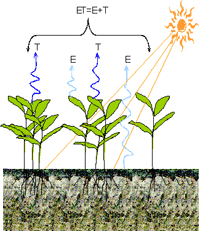Agricultural Research Division of IANR

West Central Research and Extension Center, North Platte
Date of this Version
3-2011
Citation
Published in JOURNAL OF SOIL AND WATER CONSERVATION 66:2 (March/April 2011), pp. 45A-50A. doi :10.2489/jswc.66.2.45A
Abstract
Among recent advances in developing cellulosic and noncellulosic biofuel sources, corn, switchgrass, and others (e.g., camelina, canola) have risen to the top. In surveying the landscape, a potentially promising new area of bioenergy production exists—invasive plant species. The addition of invasive plant species as a bioenergy source will help to diversify the nation’s energy dependence and help in the reduction of the negative environmental and social impacts from energy crop production. In addition, belowground carbon stores may provide an opportunity to reduce the impacts associated with global climate change.
In the agriculture sector, harvesting equipment is well advanced for facilitating efficient crop production on both small and large scales. In noncrop systems, the number of limitations and lack of need have slowed the progress of equipment development for biomass harvesting (Graneli 1984). The lack of economic return is an important reason for less intensive management in noncrop areas. With new markets emerging for cellulosic energy sources and advances in equipment technology, this increased incentive could help improve the level of management of invasive plant species in noncrop areas and subsequent harvest or removal of excess biomass.
Using invasive plant species in bioenergy facilities would provide enticing opportunities for land managers and business developers. Since the primary focus of most invasive plant species management is on control of unwanted vegetation, the massive amounts of biomass from high cellulosic plants creates a challenge for disposal. Research has shown that piling or dispersing cut portions of many woody and herbaceous invasive plant species can result in the reestablishment by new plants from propagule segments (Boose and Holt 1999; Decruyenaere and Holt 2001). With advances in processing equipment, invasive plant species biomass could be processed into pellets for transporting to facilities that burn biomass or convert biomass to liquid biofuels. The processing of invasive plant species into a useable form (i.e., pellets) that does not promote the spread or introduction of unwanted vegetation minimizes the risks of environmental contamination and provides an economic opportunity for business development in rural communities.
While corn and switchgrass are the leading plant candidates for biofuel production, they may not be the most sustainable. Alternatively, the removal of existing invasive plant species biomass and processing into pellets for combustion or liquid fuel conversion maybe more sustainable as it would comply with the US Executive Order 13112 on invasive species (Clinton 1999), support climate change initiatives (Crowl et al. 2008), and expand economic opportunities in rural areas by helping fulfill the mandate by the US Renewable Fuels Standards (USDA 2010).


Comments
This article is a U.S. government work, and is not subject to copyright in the United States.